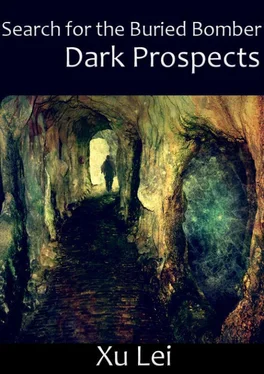The search team was extremely disheartened. They picked up the corpses and carried them out of the communication room. Pei Qing switched off the telegraph. It was still in the middle of an automatic transmission. Checking for cause of death, they discovered a black line along their gums, just like the corpse in the sinkhole. They seemed to have been poisoned to death. Old Tang had said he believed they’d been hit with some slow-acting toxin. Their deaths were far from sudden, giving them time to send the telegram. Old Cat had shaken his head and said no, that was impossible. If it was as Old Tang said, then why was there a survivor left to cover the three of them with a canvas sheet?
Usually a prospecting team will consist of no more than five to ten people. Counting these three, as well as the still-living Yuan Xile, the survivor Old Cat had guessed at, the dead soldier in the warehouse, the corpse in the sinkhole, and the madman Su Zhenhua—there might still be one or two more people we had yet to encounter.
Old Cat had ordered a group to continue searching the cavern while he and Old Tang discussed their next move. Pei Qing couldn’t get close enough to hear what they were saying. The system of tunnels and passageways was complex. Searching was far from easy. The majority of the corpsmen Old Cat had brought along were new recruits, and Old Tang was a bit of a softie. When it came to technical skill, everyone looked to him, and he was an able fighter to boot, but when difficulties arose, he lacked either the force or the charm to spur others into taking the necessary risks. The soldiers were on the verge of giving up. Even the inscrutable Old Cat could see no way out. They could swear all they wanted—and indeed some of them did—but it was of no use. For the time being, they had no choice but to stop and take some R&R. While all this was happening, I had already led the headstrong deputy squad leader and the fearless Wang Sichuan into the sinkhole and on to the gigantic underground “River 1.” At the time I had no special experience when it came to commanding soldiers, but I knew the sort of person it took to lead a squad well. A true officer should be like the deputy squad leader, obstinate in his need to carry out orders, brave and fierce like Wang Sichuan, and sly as Old Cat. Unfortunately, this sort of person was rare as could be.
As Pei Qing related their experiences to us, part of it seemed somehow illogical. Of course, Pei Qing spoke with a heavily accented form of Mandarin. I don’t know how many years Mandarin education had already been popularized, but the effects of the campaign had yet to appear. He also spoke very rapidly, and I didn’t have the energy to focus on every little detail. Still, though, it felt like something didn’t add up. In the end, Pei Qing said, it was Old Tang, a leaves-no-stone-unturned kind of guy, who figured out something was amiss. It was the telegraph room.
During the War of Resistance, wireless telegrams were used for long-distance correspondence, but the transmitter had to be located at a high point. Mountains got in the way of the signal. Transmissions were generally only made across regions of flatland. So why install a transmitter in a limestone cave at the end of an underground river? This telegraph room had certainly been in heavy use. There was a Japanese codebook and a great deal of telegraphic data lying all about. The transmission antenna, though, didn’t seem to be nearby. It was likely back on the earth’s surface, they surmised, where it could be used to contact other bases.
If this telegraph was for communicating with bases above the surface, then was it purely by chance that the signal was transferred onto the phone line? Could it be that whoever sent the message had meant to transmit the signal all the way to the surface? One therefore had to ask: Had the signal been received? Had the 723 Project headquarters known all along there was something dangerous in this cave?
It was Pei Qing who raised this question. He asked Old Cat whether, before coming after us, he’d been told a whole slew of previously concealed information. From today’s perspective, his question might seem overly direct, but given the way people dealt with each other back then, it really was the norm. Old Cat paid him not the least bit of mind. Who knows, he said. If the transmission antenna really does run all the way to the surface, then the wind and rain probably wrecked it a long time ago. This was rather intentionally missing the point. As they argued about it, Old Tang and the communications soldier went on fiddling with the automatic transmitter. Just as Pei Qing was preparing to lay into Old Cat again, Old Tang stopped them. He removed the headphones he’d been wearing and told them to listen. In addition to sending messages, the automatic transmitter could receive them as well. To verify what Old Cat had said about the surface-level antenna being broken, Old Tang had started up the machine’s receiving function. The moment he did so, an urgent string of telegraphic code immediately piped through the headphones.
I was astounded. Although intercepting cables was not difficult, especially as this was the age of telegraphic code—prior, in other words, to the introduction of frequency-hopping transmitters—still, to do so often required a lengthy process of scanning frequencies. To receive a telegram the moment you switched on the receiver meant both this transmitter and its opposite were set to the same frequency. The chances of that happening accidentally were extremely minute. Listening to the transmission, the communications soldier said something was wrong with the coding method. It seemed to be pure gibberish. Old Tang and the soldier checked the Japanese codebook. The code sounding in their headphones was actually a Japanese military cipher. So where was the antenna and where was this message coming from?
Well, first, the cable couldn’t have originated underground. That would have contravened physical laws. Second, in 1962, it would have been impossible for an antenna to receive a telegram from within Japan itself, much less one that was still using a military codebook from 1942. This cipher must have originated from someplace abandoned twenty years prior, probably some decrepit secret base nearby, left behind in the wilderness of Inner Mongolia.
None of them understood Japanese. So even with a codebook, they were unable to figure out what the cable meant. After the communications soldier listened to it for a considerable length of time, he realized that the content of the message continuously repeated. Its counterpart—wherever it was—must also be an automatic transmitter. Old Cat relaxed. Even though no one had been rescued, having found the source of the cable and this much data meant he could report the mission a success. They took detailed notes of the code being transmitted, dismantled the telegraph, packed it up along with the codebooks and deciphering equipment, and carried them out. Old Cat planned to return to the surface and let the professionals decode the message—see just what exactly the thing was saying—before deciding what to do next.
While packing everything up, Old Cat and the others had another pleasant surprise. One of the privates was going through a stack of data books when he discovered several engineering blueprints, one of which proved especially crucial. Only half the drawing could be made out, but in that legible section was a meticulous depiction of the area around the dam, the plane’s takeoff structure, and all the underground river’s various tributaries. Relying on this blueprint, they made their way through the branching paths of the limestone cavern. They entered a sinkhole and, following a group of power cables, navigated the tunnel system underneath for over ten hours until they finally reached one side of the dam. There were a couple minor adventures after that, and then they bumped into us.
Читать дальше












